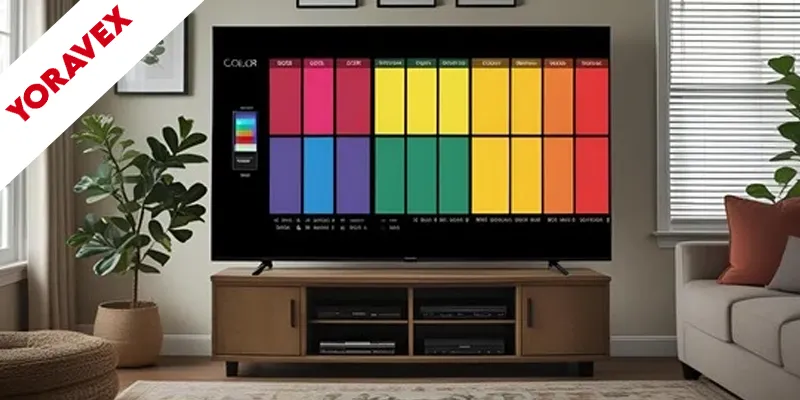If you want a clean, accurate picture from your TV, start smart—Calibrate TV picture settings first. Pick a calibrated mode like ISF or Cinema, set color temperature to Warm, and switch off extras that add fake polish. Then use simple test patterns to Calibrate TV picture settings for brightness and contrast, keep sharpness low, and avoid over-saturated color. Create separate profiles for HDR and non‑HDR so each shines. You’ll see real detail and natural skin tones—once you Calibrate TV picture settings with a few precise tweaks that most people skip.
Key Takeaways
- Choose an accurate picture mode (ISF/Cinema/Theater/Custom) and disable vivid, game, and sports presets to Calibrate TV picture settings.
- Set Color Temperature to Warm (Warm1/Warm2) for natural skin tones and accurate grading as you Calibrate TV picture settings.
- Turn off motion smoothing, dynamic contrast, noise reduction, and disable overscan (Just Scan/1:1) to Calibrate TV picture settings accurately.
- Adjust Brightness so bars 17–25 barely flash; set Contrast to avoid clipping above 238. This helps you Calibrate TV picture settings precisely.
- Keep sharpness near zero, tame saturation, and create separate calibrated profiles for SDR and HDR when you Calibrate TV picture settings.
Choose the Right Picture Mode
Before you tweak anything else, Calibrate TV picture settings by picking a picture mode that prioritizes accuracy. To Calibrate TV picture settings, choose the right picture mode first, because it unlocks advanced color settings and gives you a clean starting point. Start with ISF if your set offers it; Cinema, Theater, or Custom modes are strong alternatives. Skip Vivid, Game, and Sports modes during calibration—they push contrast and saturation, hurting accuracy and masking issues.
Once you’ve selected a precise picture mode, disable adaptive processing like motion smoothing and dynamic contrast so your adjustments reflect the signal, not the TV’s algorithms. Most modern TVs already track well in these standard modes, so you’ll get the best results with fewer adjustments. From here, refine color settings methodically and verify with familiar content.
Set Color Temperature to Warm
Two quick clicks can transform your picture: Calibrate TV picture settings by setting Color Temperature to Warm. You’ll cut the harsh blue tint common in cooler presets and unlock more accurate colors instantly. Most modern TVs include a warm preset tuned for typical rooms, so it’s a smart first move in TV calibration.
Switching to a warm setting aligns your screen with how movies and shows were graded, delivering a natural viewing experience that matches the filmmaker’s intent. You’ll notice lifelike skin tones, richer midtones, and nuanced highlights that boost overall picture quality without extra tweaks.
Start with Warm (or Warm1/Warm2 if offered) and watch a familiar scene. If faces look natural and whites don’t appear bluish, you’re dialed in. Pros use this as the baseline before any fine adjustments.
Turn Off Extra Processing and Overscan
With color temperature set to Warm, strip away the TV’s “help.” Turn off motion smoothing, adaptive contrast, dynamic tone mapping, noise reduction, and any “vivid” or “enhancement” modes so the image reflects the source accurately. Open the picture settings menu and disable every extra processor that alters frame rate, sharpness, or color to Calibrate TV picture settings. You’ll get closer to the creator’s intent and a stable baseline for calibration.
Next, eliminate overscan. In the picture settings menu, set aspect ratio to Normal, 1:1, or Just Scan so the TV shows every pixel without cropping or scaling—essential when you Calibrate TV picture settings. This preserves geometry and prevents hidden edges or distorted shapes. Use a calibration disc or test pattern to confirm that borders and circles align. With processing off and overscan corrected, you’ll approach the best picture.
Adjust Brightness (Black Level) Correctly
How do you set black level so shadows look rich without crushing detail when you Calibrate TV picture settings? Start with a gray-scale test pattern that shows bars from 0 to 255. Raise Brightness until bars 17–25 begin to flash or become barely visible, while bars 2–16 stay fully black. Then lower slightly to the lowest point where those first few bars remain visible. That’s your correct black level.
Make small adjustments; big jumps can wash out shadow nuance. Don’t push Brightness so high that the darker bars turn gray, or you’ll lift blacks and lose depth. After you calibrate, note the setting value for future reference.
Recheck this step whenever you tweak contrast, since these adjustments interact. Reassess in your normal viewing environment, as ambient light can alter perceived black level.
Dial in Contrast (White Level) With Test Patterns
Next, Calibrate TV picture settings for white level using a proper Contrast pattern. Load the Contrast test pattern on your disc and adjust the settings until bars below 238 show distinct shades of gray, while bars above 238 appear white. If the bars stop flashing as you raise Contrast, you’ve gone too high; back it down until at least half the bars flash cleanly and the rest remain visible as gray. This balance preserves highlight detail and prevents clipping, so the brightest parts of the picture look accurate rather than blown out.
Confirm the adjustment with real content. Check bright clouds, chrome, or snow for texture, not a flat white block. Revisit the Contrast control under different lighting and sources to ensure the setting holds up across material without sacrificing detail.
Keep Sharpness and Color Enhancements Minimal
Sometimes the cleanest picture comes from dialing things back. Start with sharpness settings near zero to avoid halos and grain that blur fine detail. Many TVs ship with edge enhancement cranked up, so reduce it until textures look crisp without glowing outlines. Next, temper color saturation. Aim for vivid yet believable hues; if skin tones look neon or grass glows, back off.
Use test patterns to find the threshold where adjustments start hurting picture quality. Raise sharpness or color slowly, then stop the moment you see ringing, speckling, or oversaturated patches. Factory presets can be a safe baseline, but don’t hesitate to make minimal adjustments.
Recheck these controls after changing brightness or contrast. Small tweaks preserve a natural appearance and keep everything balanced.
Fine-Tune for HDR and Save Separate Profiles
Start HDR calibration by maxing the backlight so specular highlights pop, then switch to HDR-specific test patterns to dial in color accuracy. Use those patterns to verify grayscale and color saturation, since small hue shifts can undermine picture quality. Next, adjust tone mapping in HDR mode so bright details don’t clip and shadow texture stays visible. If your TV offers dynamic tone mapping, compare it with static options and pick the one that preserves detail without crushing blacks or blowing out highlights.
HDR often needs different settings than SDR, so create separate profiles. Save a dedicated HDR profile with your calibrated settings, and a non-HDR profile for cable or Blu‑ray. Finally, confirm your TV doesn’t revert when inputs change—resave the HDR profile if it does.
Frequently Asked Questions
How to Calibrate Your TV for the Best Picture?
You calibrate by choosing ISF modes like Cinema/Custom, set Color Temperature to Warm, use a calibration disc to tune Brightness/Contrast, disable motion smoothing/dynamic contrast, document settings, and feed the highest-quality signal. Recheck periodically as lighting and sources change.
How to Get the Perfect Picture on Your TV?
Choose Cinema/ISF/Custom, set Warm color temperature, and disable motion smoothing and noise reduction. Use a Spears & Munsil disc to tune brightness and contrast for shadow/highlight detail. Save notes on every change so you can reapply settings.
How Do I Make My TV Settings so My TV Looks Better?
Choose ISF/Cinema/Custom mode, set Color Temperature to Warm, and disable motion smoothing/noise reduction. Use a calibration disc: raise Brightness until darkest bars barely show, Contrast until brightest bars separate. Save settings so you can restore them.
What Is the Most Accurate TV Picture Mode?
ISF mode’s usually the most accurate. If it’s missing, choose Cinema/Theater or Custom, or try Filmmaker Mode. Avoid Vivid, Game, and Sports. Set color temperature to Warm, then fine-tune brightness, contrast, and sharpness conservatively for natural results.
Conclusion
You’re now ready to get a stunning, accurate picture without the gimmicks. Pick an honest mode, set color temp to Warm, and kill extra processing and overscan. Use test patterns to lock in black and white levels, then keep sharpness and color tweaks subtle so detail shines without halos or oversaturation. Finally, fine-tune HDR separately and save profiles. Take a few minutes, trust your eyes, and you’ll enjoy films, sports, and games exactly as intended.
![Yoravex – Smart Tech Guides, Fixes & Tips [2025]](https://yoravex.com/wp-content/uploads/2025/08/cropped-wwwwwwwwwwwwwwwwww.png)


